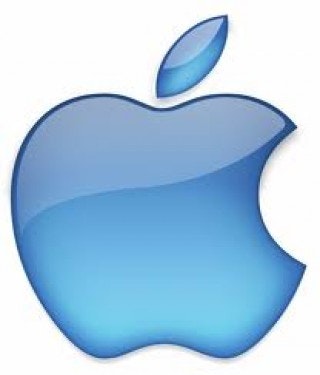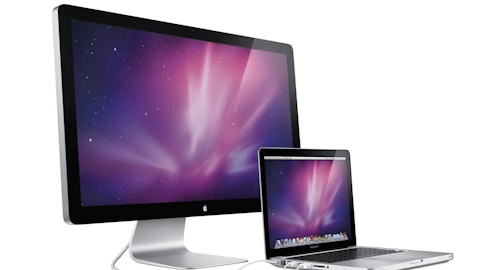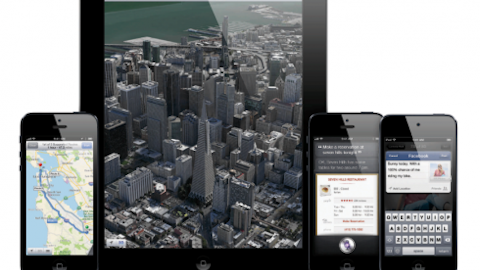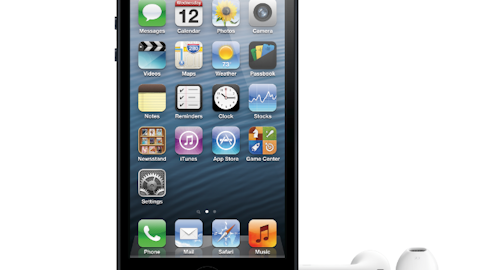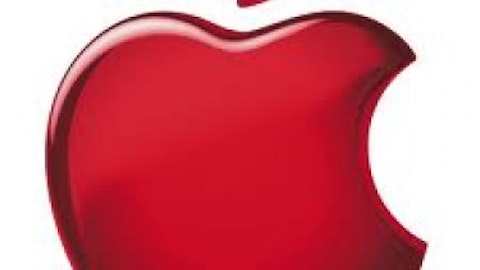When Apple Inc. (NASDAQ:AAPL) reported its Q4FY12 earnings in October, management projected that margins would drop significantly in Q1FY13 (the period ending in late December) to 36%. In the same quarter a year ago, gross margins were substantially higher at 44.7%.
Evaluating Apple’s likely gross margin profile is very difficult because the company consistently lowballs its estimates for revenue, gross margin, and profit. Analysts at Deutsche Bank have pointed out that Apple Inc. (NASDAQ:AAPL)’s gross margin forecasts have historically been 200-400 basis points below the actual figures. This implies gross margin for Q1 will be 38%-40%. According to one analyst, the current Wall Street consensus falls near the bottom of this range at 38.3%.
By contrast, I believe that strong sales of the high-margin iPhone will result in margins near the top of the range at 40%, with some upside potential beyond that.
Improving yields
One reason for optimism is that low manufacturing yields, which plagued initial production of the iPhone 5, appear to have been resolved relatively early in Q1. Management’s justification for the low gross margin target was that Apple Inc. (NASDAQ:AAPL)was going through the heaviest new-product-launch cycle in its history. Low initial yields and other start-up costs were therefore expected to create a major gross margin headwind. However, it seems quite likely that Tim Cook was being especially conservative with his forecast this quarter, in light of the higher uncertainty.
Earlier this week, Apple shares were driven down by reports from Nikkei (repeated in the Wall Street Journal and elsewhere) that Apple Inc. (NASDAQ:AAPL) had slashed its March-quarter orders from various iPhone 5 suppliers. However, this apparent bad news is also consistent with a second interpretation: Apple cut orders because of better than expected yields during Q1.
This interpretation is supported by other data regarding component order cuts. In December, Citi analyst Glen Yeung (who is no Apple bull) wrote, “Supply of iPhone5 has improved. Our checks suggest Apple Inc. (NASDAQ:AAPL) has seen a 45-50% increase in monthly iPhone5 production output October to December. While some of this increase was anticipated, our discussions with various points in the supply chain indicate yield improved faster-than-expected.”
A faster-than-expected increase in yields would drive down costs and points toward better gross margins than Apple Inc. (NASDAQ:AAPL)initially projected. It also points towards higher production and thus higher iPhone revenue.
Improving mix
The current fall refresh cycle for the iPhone has led to very high iPhone sales in fiscal Q1, and relatively high sales in Q2, followed by more moderate sales through the rest of the year. Apple’s iPhone and related revenue of $24.4 billion in Q1FY12 accounted for 52.7% of the company’s total revenue during the quarter. I expect the iPhone’s share of total Apple Inc. (NASDAQ:AAPL) revenue to grow year-over-year by approximately 500 basis points (to 57%-58%).
The iPod and Mac lines (approxmiately 20% of revenue in Q1FY12) are being cannibalized by the iPhone and iPad. As a result, these two product lines combined will see revenue slightly lower this year, while the iPhone and iPad continue to show strong revenue growth. The iPad should hold at roughly 20% of Apple’s revenue, with the iPhone line taking share from Mac and iPod. This “mix shift” is significant because the iPhone has vastly better gross margins than the Mac and iPod lines, as can be seen in the chart below (courtesy of Asymco):
With the iPhone offering 20%-30% higher gross margins than the iPod or Mac lines, this mix shift away from lower-margin products towards the iPhone should provide a gross margin tailwind of 1%-1.5%.
We are also likely to see a mix shift within the iPhone line towards lower-priced older models. I was recently in Best Buy Co., Inc. (NYSE:BBY) when another customer asked for some advice about whether to buy the iPhone 5 or the iPhone 4S. Best Buy was offering a special discounted price of $49 for the 4S with a two-year contract (and free for open box or refurbished models). Like many others, the customer who approached me ultimately chose to buy an iPhone 4S.
Older iPhone models still provide a very good user experience, so many people are opting for those lower priced phones. A survey by Consumer Intelligence Research Partners showed that 32% of iPhone buyers opted for the iPhone 4 or 4S in the first month after the iPhone 5’s release, whereas only 10% of iPhone buyers chose older models when the iPhone 4S came on the market. (Part of this shift was probably the result of iPhone 5 shortages.)
While the iPhone 4 and 4S offer lower profit per device than the iPhone 5, they offer higher gross margins on a percentage basis. For example, Apple Inc. (NASDAQ:AAPL) offers the iPhone 4 unlocked for $450 (or free with a carrier subsidy), but IHS iSuppli estimated the bill of materials at less than $200 in June, 2010. With memory and display prices having dropped significantly since then, the COGS (cost of goods sold) is probably around $150 now. After accounting for logistics/selling costs, Apple should still earn more than $200 in profit per device (i.e. more than 50% gross margins).
So while I expect the iPhone’s ASP to drop from $660 last year to roughly $630 last quarter, the product’s gross margins should still hold at 50% or above. (For reference, iPhone gross margins ranged between 49% and 58% between April 2010 and March 2012.)
Will competition lead to price chopping?
As noted above, the iPhone is the primary driver of Apple’s high gross margins. Some observers are worried that rising competition from Samsung, as well as a resurgent Nokia Corporation (NYSE:NOK) or Research In Motion Limited (NASDAQ:RIMM) will soon force Apple Inc. (NASDAQ:AAPL) to cut prices or introduce a lower-cost smartphone in order to maintain market share.
RIM is introducing the new line of “Blackberry 10” phones in two weeks. These phones have some innovative new features, but the all-touch versions clearly take their cues from the iPhone. RIM has been losing smartphone market share for several years, and while the new OS may be able to stem the tide, it’s unlikely to jumpstart rapid growth. While Apple sold roughly 125 million iPhones in FY12 alone, there are only 80 million Blackberry users worldwide.
The story is similar for Nokia. While Nokia once had the smartphone lead, its Symbian OS was no match for iOS, which eventually led to the company’s transition to the Windows Phone platform. Nokia recently reported strong sales of its “Lumia” line of smartphones. But while Lumia sales quadrupled year-over-year to 4.4 million units in Q4, the iPhone sold more than ten times as many units. Clearly, Nokia is not even close to regaining a meaningful share of the high-end smartphone market.
Nokia’s recent deal to offer a subsidized phone through China Mobile Ltd. (NYSE:CHL), China’s largest wireless carrier, is a big win for Nokia and an incremental negative for Apple. However, consumer demand for the iPhone will probably force China Mobile to come to an agreement with Apple Inc. (NASDAQ:AAPL) in the next year; otherwise it will continue losing 3G market share to its smaller rivals. While the Lumia may be successful, there are still plenty of China Mobile subscribers who will want an iPhone.
Samsung is clearly the biggest threat. The company recently announced that it had sold more than 100 million units of its high-end Galaxy S smartphone line since its launch in May, 2010. That said, Apple sold more than twice as many iPhones over the same period of time. Samsung offers a broad range of smartphones, unlike Apple, which have allowed it to take a leading share of the worldwide market. However, Apple Inc. (NASDAQ:AAPL) has long shown that it does not need to maintain a #1 market share position to earn more than 50% of the smartphone market’s profits.
Moreover, Apple is gaining market share in the highly profitable U.S., where it now has 35% share of total smartphone subscribers. More than 53% of smartphones sold from September to November in the U.S. were iPhones! The engrained smartphone subsidy model in the U.S. should stave off pricing pressure, negating Samsung’s key advantage of having numerous price points.
In future years, I expect a steady U.S. iPhone upgrade cycle to generate $15-$20 billion of annual operating profit for Apple Inc. (NASDAQ:AAPL). This solid base of profitability means that Apple does not have to go “bottom-fishing” with Samsung in international markets anytime soon. Apple can continue to cultivate a premium feel and sell to wealther consumers in developing countries, while allowing Samsung and other vendors to sell low-end, low-margin smartphones to the mass market.
Conclusion
My expectation for Q1FY12 iPhone sales of 53 million units at an ASP of $630 implies revenue of $33.4 billion from this product alone. Assuming an iPhone gross margin of 50%, with iPhone revenue at 57.5% of Apple’s total, a 40% company gross margin seems very acheivable (gross margin from the rest of Apple’s product portfolio would need to be 26.5% or higher). My analysis implies that Apple Inc. (NASDAQ:AAPL) could exceed $15 EPS for Q1, which would easily beat the current Wall Street consensus.
The biggest risk to this thesis is a shortfall in iPhone sales, which would put pressure on revenue and company gross margins. However, AT&T and Verizon have already reported strong iPhone sales last quarter, and the iPhone’s quick international rollout also supports an estimate of 50-55 million iPhones shipped.
The article Apple: Near-Term Margin Worries Are Overblown originally appeared on Fool.com.
Copyright © 1995 – 2013 The Motley Fool, LLC. All rights reserved. The Motley Fool has a disclosure policy.
